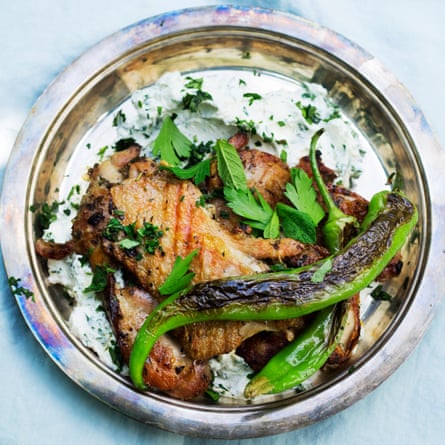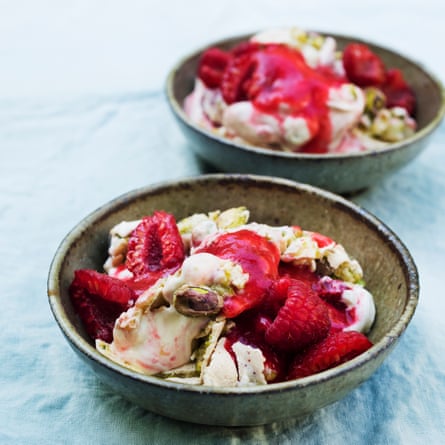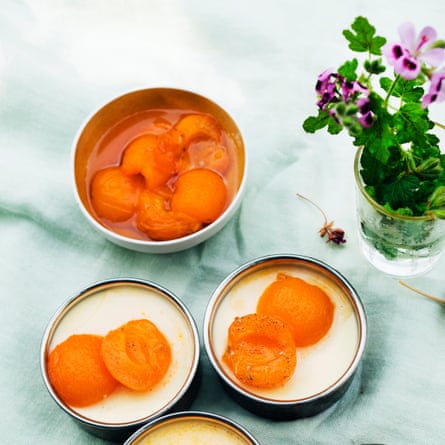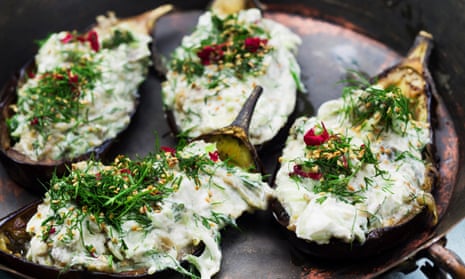If there is a theme running through this summer’s cooking it is that of yogurt and its strained and lightly salted cousin labneh. At breakfast, I prefer the wake-up-call sharpness of sheep’s milk yoghurt, often with a glowing puree of alphonso mango and a lightly sweetened compote of blueberries or blackcurrants. Used as replacement for some of the cream in a fruit fool, the refreshingly acidic notes of goat’s milk yogurt flatters the flavours of apricots, strawberries and raspberries, as well as making the dessert less rich. Homemade labneh, made with thick yogurt left to strain overnight through a muslin, has been in my fridge all summer long. I use it as it comes, or with basil and mint threaded through and maybe a little black pepper. Cold for the fridge it accompanies lamb and chicken from the grill, and last week I used it to stuff aubergines with shredded cucumber and garlic. The blander, sweeter cow’s milk variety can be used for this.
Labneh
You will need a large square of cheesecloth.
Makes about 500g
sea salt 1 tsp
strained yogurt 500g
Stir the salt into the strained yogurt. Line a sieve with a piece of cheesecloth (a new J cloth will do at a push), then suspend it over a bowl. Scrape the yogurt into the lined sieve, place the sieve and bowl in the refrigerator and leave to drip overnight. By morning you will have a thick cream that will hold its shape. Should you want something spreadable, then you could leave it for another 24 hours.
Stuffed aubergine with labneh and cucumber
I love the soft, luscious stuffed aubergines of the Middle East, especially when they are allowed to stand after cooking and can be eaten just warm and when their flavours have time to marry. Rather than the usual tomato and onion stuffing, earlier this week I made a refreshing filling with salted yogurt, cucumber and the flesh of the roasted aubergine. The recipe involved two textures of cucumber, one soft and mildy salted, the other fresh crisp. Both were folded, together with the soft aubergine into the labneh and stuffed into the aubergine shell with sesame and dill. One of those dishes that is pleasing warm or cold.
Serves 4
cucumber 1 large
salt 1 tsp
small, plump aubergines 4
olive oil 8 tbsp
a head of garlic
labneh 200g
sesame seeds 2 tbsp
dill a handful
rose petals (optional)
Set the oven at 200C/gas mark 6. Peel the cucumber, slice in half lengthways then, using a teaspoon, remove and discard the seedy core. Coarsely grate the cucumber, using the largest ‘matchstick’ disc on the food processor.
Divide the cucumber into two piles, place one half in a sieve balancing over a bowl, sprinkle with the teaspoon of salt then leave in a cool place for an hour. This will introduce a soft, silky texture. Put the other half in a bowl, cover and refrigerate.
Halve the aubergines lengthways, then score them, almost through to the skin, in a lattice fashion. This encourages the olive oil to penetrate more thoroughly. Place the aubergines snugly and cut side up in a roasting tin, trickle over the olive oil, add the whole head of garlic, unpeeled, to the tin, then bake for about 45 minutes until the aubergine’s flesh is soft and completely tender.
Remove the aubergines from the oven and scrape their flesh into a bowl, returning each empty skin to the tin. Peel the garlic, squeezing the soft, creamy filling into the warm aubergine flesh. Squeeze the salted cucumber dry in your hand, then add, together with the matchsticks of crisp cucumber to the aubergine. Season with black pepper. Add the labneh, then fold the ingredients together.
Spoon the filling into the aubergine skins. Toast the sesame seeds in a dry, shallow pan till golden, chop the dill and, if you are using them, the rose petals. Mix the seeds, dill and petals then scatter over the filling and serve.
Grilled chicken, herb labneh

I would be happy to eat sizzling, crisp-skinned chicken and chilled, herbed yogurt all summer long.
Serves 2
For the marinade
oregano leaves 2 tbsp
olive oil 6 tbsp
garlic 3 large cloves
peppercorns a few
chicken legs 2
labneh 300g
basil 10g
mint 10g
parsley 10g
long thin Turkish peppers 2
Roughly chop the oregano leaves, put them in a shallow dish large enough to take the chicken, then add the olive oil. Peel and crush the garlic and stir into the marinade. Roughly crush a few peppercorns and add.
Remove the bone from the chicken legs with a sharp kitchen knife. The easiest way to go about this is to place the chicken leg flat on a chopping board, plumpest side down, then, following the line of the bone with your knife, cut through the skin and flesh easing the bone out from within the flesh as you go. Worry not about the occasional hole or tear.
Using a piece of cellophane or clingfilm to wrap the meat and a cutlet bat or rolling pin, flatten each leg out to about 1cm in thickness. A few firm, measured blows should do it. Peel the meat from the cellophane, place the meat in the marinade, cover, and leave in the fridge for a couple of hours.
Put the labneh in a bowl. Remove the leaves from the the basil, mint and parsley, leaving a few whole leaves for later, then roughly chop or tear and fold into the labneh, season with black pepper, cover and chill. Get a ridged griddle pan hot. Remove the chicken from the marinade, shake off any excess oil then cook, skin side down for 7-8 minutes until the skin is lightly crisp. You should expect some smoke. Turn the meat over and cook the other side, brushing with some of the marinade as necessary.
As the meat is cooking, place the peppers onto the griddle too, turning them as they brown. Spoon some of the herb labneh onto a serving plate, then place the chicken, hot from the grill on top. A few of the reserved herbs, torn and scattered over the hot meat is a thoroughly fragrant thing.
Raspberry fool, pistachio meringue

Serves 6
For the meringue
caster sugar 250g
shelled pistachios 95g
egg whites 4
For the fool
double cream 250ml
raspberries 250g
natural yogurt 150ml
To finish
raspberries 125g
Put a large mixing bowl in the fridge to chill.
Set the oven at 140C/gas mark 1. Spread the sugar on a baking sheet and heat for 5 minutes till slightly warm to the touch. Chop the pistachios finely in a food processor. Beat the egg whites until they start to stiffen (though they should not be quite stiff enough to stand in peaks) then add the sugar a large spoonful at a time, beating continuously. Carry on, with the beater at high speed, for 3-4 minutes until the meringue is thick and glossy. Line the empty baking sheet with baking parchment.
Fold the crushed pistachios into the meringue, then spread onto the baking parchment, smoothing the mixture flat and almost right out to the edges. Place the meringue in the oven and bake for 25 minutes. It will be lightly crisp on top, softer underneath. Remove and allow to cool.
For the fool, pour the cream into the chilled bowl, beat slowly and firmly until it is just thick enough to hold it shape. Process the raspberries to a puree then push through a sieve into a bowl or jug to remove the seeds.
Fold the yogurt and half the raspberry puree partially into the cream, leaving ribbons of yogurt and scarlet fruit sauce running through the cream. Break the pistachio meringue into rough pieces, and fold gently into the fool, keeping the pieces large and avoiding the temptation to “mix thoroughly”. Serve in small bowls. Add a few extra raspberries and the remaining puree to finish.
Baked yogurt with apricots

A light yogurt custard that sets to the consistency of a creme brulee.
Serves 4
For the apricots
apricots 500g
cardamom 12
sugar 3 tbsp
water 400ml
rosewater 1 tbsp
cinnamon stick half
For the baked yogurt
double cream 250ml
condensed milk 200ml
yogurt 300ml
Halve the apricots and remove their stones. Crack the cardamom pods, remove the black seeds within and grind to a very fine powder with a pestle and mortar. Put the sugar and water in a medium-sized pan, add the rosewater, ground cardamom and cinnamon stick and bring to the boil.
Lower in the apricots, turn the heat down so that the syrup simmers gently, and leave for 15 minutes or so, till the fruit is soft and tender. Remove from the heat and set aside to cool. Chill in the refrigerator.
Set the oven at 150C/gas mark 2. Put the double cream in a large bowl, stir in the condensed milk and then the yogurt. A whisk is useful. Pour the mixture through a fine sieve into a jug.
Fill a roasting tin with enough water to come halfway up the sides of 4 small heatproof dishes or ramekins that will each hold 200ml. Place the dishes in the tin, then carefully pour the custard into each one and bake for 15-18 minutes until the custard is starting to set. The middle should be barely set. Remove from the oven, take the dishes out of the water and chill them in the fridge for a minimum of 2 hours.
Serve the custards with some of the chilled apricots on top, the rest offered in a bowl.
Mango and blackcurrant breakfast bowl

I have started my day with sheep’s or goat’s yogurt for decades. In summer, it is usually mixed with a classic mixture of seeds, nuts and oats, but also fresh fruit compote and puree. A dazzling start to the day. It is not worth making less compote than the amount below, but it will keep for several days in the fridge.
Serves 2
For the blackcurrant compote
blackcurrants 200g
caster sugar 2 tbsp
water 4 tbsp
jumbo oats 50g
medium oatmeal 40g
flaked almonds 40g
hazelnuts, shelled 24
pumpkin seeds 20g
mangoes, small, ripe 2
natural yogurt 250ml
Pull the blackcurrants from their stalks, drop them into a small, stainless steel saucepan, add the sugar and water and bring to the boil. Lower the heat and leave to simmer for 5 or 6 minutes, till the fruit pops and is surrounded by deep purple juice. Remove the pan from the heat and set aside.
Warm a shallow pan over a moderate heat, add the oats and oatmeal, the flaked almonds, hazelnuts and pumpkin seeds and toast till the oats are tightly golden and the almonds are fragrant. Set aside.
Peel the mangoes then slice the flesh from their stones. Process to a puree using a blender or food processor.
Spoon the yogurt into a serving bowl. Spoon in the mango puree, about half blackcurrants and their juice then scatter the oats, nuts and seeds over the surface. Stir briefly then serve.
Email Nigel at nigel.slater@observer.co.uk or follow him on Twitter @NigelSlater
